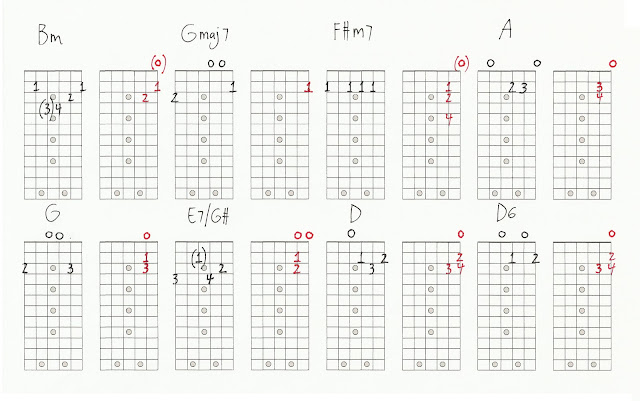Hello!
Welcome once again to a new entry of this blog.
A few days ago I received an email from Frank, a former student. He mentioned he was interested in making a finger-style arrangement of "Logical Song" by Supertramp.
I thought it wold be a good idea for this blog, so I'm going to show you step by step how to create an easy one guitar arrangement using this song as an example.
The idea is to create a guitar piece including the harmony (chords), the rhythm, the lead melody and riffs.
The first step I followed was to learn the chords and the structure of the song. I've copied my first notes here:
The first step I followed was to learn the chords and the structure of the song. I've copied my first notes here:
I normally use ">" to indicate that a section of the song has to be repeated. For instance, after Verse 1, I've written "> Verse 2", which means "go to Verse 2" (in this case it will be exactly the same as Verse 1).
Next thing will be to check if the original key is the most appropriate for the arrangement.
I decided to use a capo on fret one in order to avoid bar chords and also to play chords and melody together easily.
Once the capo is ready, we have to use new chord positions. It's like transposing the song (changing the key).
The following image is my transcription with all the main elements.

The following diagrams will help you to learn the chords involved in the arrangement (black), and also the melody (red). As you can see, each chord matches a section of the melody.
I would recommend you to use this diagrams in conjunction with the previous Tab.
In order to play the melody notes in red in the right order, you should do it by ear, o just checking the Tab.



The final step consists in trying to put everything together, maybe using the metronome, and also adding a few notes to fill the gaps between the melody notes or the riff.
I've recorded two videos where you'll see me playing the final result. I play it slowly in the first one, and then I play it at the original tempo (118bpm).
I decided not to use the capo, just in case you don't have one with you, and also to have a better control of the tuning. Sometimes the capo is pushing too much the strings against the fretboard, so you need to double check the tuning, and that can be tricky.
I wanted to focus in the arrangement, but in case you're also interested in practicing the improvisation I've created a backing track with the Verse's chord sequence, which is also the accompaniment for the sax solo.
Here is the chord progression, which will repeat for 40 times:
||: 4/4 Cm | 2/4 Ab | 4/4 Gm | Bb |2/4 Ab | 4/4 F7/A |
| 4/4 Cm | 2/4 Ab | 4/4 Gm | Bb |2/4 Ab | 4/4 F7/A | F7/A :||
| 4/4 Cm | 2/4 Ab | 4/4 Gm | Bb |2/4 Ab | 4/4 F7/A | F7/A :||
The following image will take you to the section of my web where you'll find it, right at the end of the page.

I've also recorded an improvisation over this chord sequence. I'm mainly using C Minor Pentatonic Scale, and I've also added notes from the Natural Minor Scale (Aeolian Mode).
C Natural Minor Scale
(C Pentatonic Minor Scale)
(C Pentatonic Minor Scale)
C D Eb F G Ab Bb
All the chords in this sequence belong to C Natural Minor Scale, except for F7/A, which in this case belongs to C Dorian Scale.
C Dorian Scale
(C Minor Pentatonic Scale)
C D Eb F G A Bb
Pentatonic Minor Scale will be a safe option to improvise here, because it works well in both C Aeolian and C Dorian.
I hope you find this information useful.
If you need me to explain further something or just want me to add some extra stuff, please let me know, and I'll update this blog as soon as I can.
I would recommend you to try an arrangement like this. You should start with a song you are very familiar with. If you know the chords very well, just try to follow these steps.
You can let me know how it goes.
Regards,
Jose



1.jpg)
.+Acorde+&+Escala+-+joemoreg.blogspot.bmp)
.+Acord.+Scl.+-+joemoreg.blogspot+(2).jpg)
.+Acrd+&+Escl+-+joemoreg.blogspot+(3).jpg)